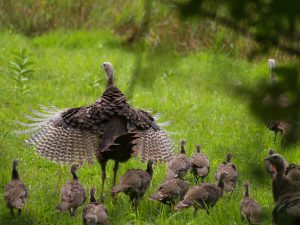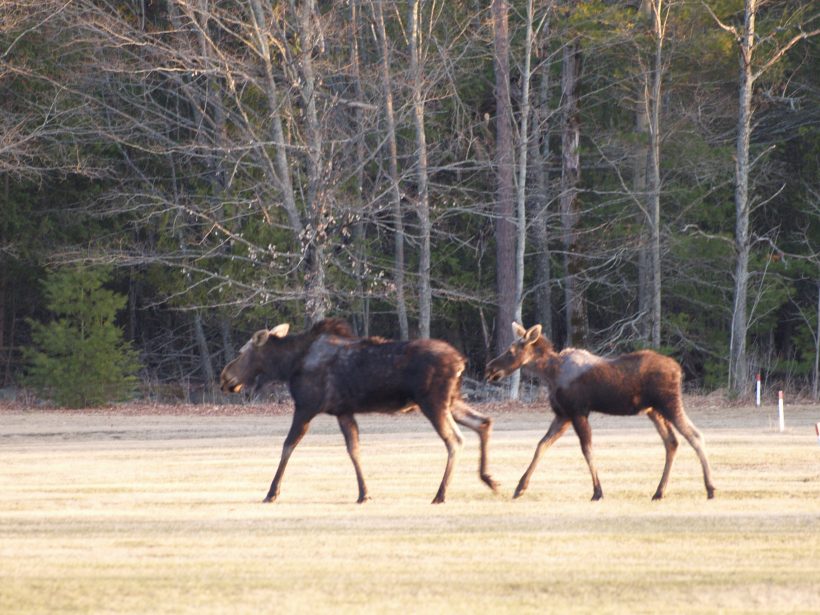HUNTING IN ALGONQUIN PARK
Hunting pre-dates the birth of Algonquin National Park although wild game may not have been as abundant as it is to-day. The explorer David Thompson complained of a lack of wildlife in what we now regard as Algonquin Provincial Park.
In 1893 when Peter Thompson assumed command he immediately recommended that a ban on moose hunting be extended for five years and that prairie chicken should be introduced to supplement the ducks and partridge of the Park. He was concerned about the practice of building dams on rivers for log drives. “Since there are no fishways or ladders the fish are unable to ascend the streams and consequently (are) deceasing in numbers.”
Following his investigative canoe trip through the Park James Wilson, Superintendent of Queen Victoria, Niagara Falls Park, recommended eliminating the wolf, the loon and the gull; the latter two because they harmed the fish populations and were of no economic value. In fact, the Park Rangers used loon skins as inserts in their footwear for added comfort and waterproofing.
Dinny McGuey farmed the “Old Place” eight miles above Basin Lake in the Park for 40 years. Superintendent Bartlett offered him $2500 plus appointment as a Fire Ranger. (The reader may see these letters in the New Visitors’ Centre near the talking lumberman exhibit.) According to Dinny’s grandson Rod McGuey, Bartlett was especially keen to put Dinny on the payroll to curb the family’s prolific need to hunt and fish for sustenance. “When the Tamarack turned golden they went fishing for Lake Trout and caught them by the barrel full, to last the winter.”
Nighttime Jack lighting moose was another story. According to Rod McGuey, “One man would paddle up to a feeding moose. The hunter, in the bow, wore a birch bark hat complete with a hidden lighted candle. When close to the moose the hunter would open a little door and the candle flame would mesmerize the animal for an easy kill.” One might wonder how many heads of hair caught fire?
In 1897 Superintendent Bartlett introduced Canada Geese that had to be fenced in to keep the deer out. He also introduced 10 Wapiti (American elk) near Cache Lake, wild turkey and Capercaille, the world’s largest grouse, imported from Norway. As an aside, I once met an international wildlife photographer from New York State at the Bancroft Retriever Trials held in October of the year. He had entered his Goldens. He was taking photos and had a lens that was as big as my thigh- and heavy. You could see the nose hairs of a flea at 100 yards. He told me that he had spent a couple of miserable weeks in the Norwegian wilds in order to film some Capercaille. Upon re-entry to the U.S. customs officials exposed all of his film destroying his work. At which time he decided, “no more; and retired.”

“In spite of the infiltration of wolves from surrounding areas almost as fast as they could be killed by Rangers deer increased rapidly in the Park.” That, combined with a severe domestic meat shortage during WW1 caused Superintendent Bartlett to recommend hunting deer in the Park to help offset such a shortage. Bartlett’s 1918 report stated that 650 deer had been shipped to Toronto increasing the Park’s cash flow by $5094.34. The Rangers would deposit the deer carcasses along the railway tracks and Edwin Thomas, using a railway motor car, would pick them up and deliver them to the Joe Lake Station for transport south to Toronto and Hamilton.
To-day’s mature forests provide less succulent secondary growth for the deer but the habitat has become more ideal for a resident moose herd that seems to have peaked at 4400 in the mid 1990s. By 2024 it had declined to approximately 3000.
During the 1993 100th Anniversary Centennial celebrations roadside sightings became so common that an adoring public jokingly accused Park employees of training moose for such wonderful viewing opportunities. For old timers it was reminiscent of the deer sightings of the 1950s.
Where nature is concerned theories abound but the facts are slow to surface. When the dreaded moose ticks became almost epidemic some hypothesized that a smaller more dispersed herd would reduce the chances of moose ticks finding moose. Moose were the necessary host. Nothing else would do. Not man, nor deer even mice. Perhaps, some suggested, with the Golden Lake Band hunting moose in the Park they would be contributing to a healthier more vibrant tick free herd. Perhaps.
Another theory relates to the Black Bear. During A.P.’s history there have been approximately three incidents of bear related fatalities. Some believe that A.P.’s black bear is gradually losing its fear of people because it no longer is hunted. Hunting, ‘they’ claim, motivates such fear. Some believe that nuisance bears that invade campgrounds and garbage dumps have lost their natural fear of people and the transition from eating garbage to people is but a small step.
“Not so,” argued Park Naturalist, now retired, Dan Strickland whose career was in A.P. “There is no evidence to support such theory.”
With so few altercations perhaps they can be put down to freaks of nature?
J.W. Millar has to have been one of the most photographed men ever to be Superintendent of A.P. During his tenure of hard economic times a policy of re-trenchment was in place and he did his utmost to create a high profile for both himself and the Park. And so we see him petting deer, holding endless strings of fish (remember, at this time, they thought the resource was infinite) and sitting in front of three dead bear. “There was no bear hunting in the Park” one determined individual told me. However, the photo, showing Super. Millar, Chief Ranger W. L. “Will” Lewis and Park Ranger Jack Gervais at Cache Lake, 1926 indicate otherwise.
![Trail Camera[MP:02][TP:009C][IMEI:864049051274589]](https://thetimetraveller.ca/wp-content/uploads/2024/03/2a.-Rosseau-black-bears-300x169.jpg)
NEXT – Fishing in A.P.
